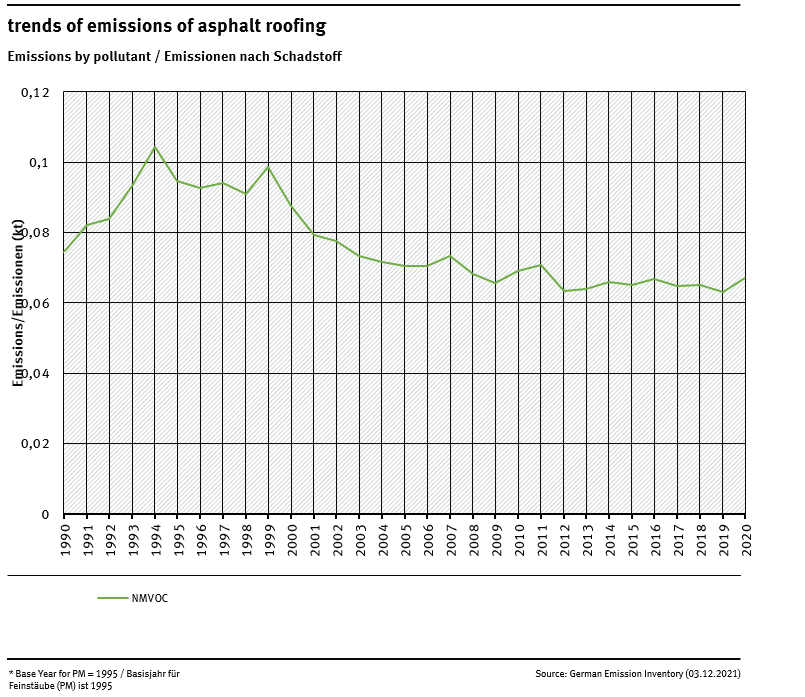meta data for this page
2.D.3.c - Asphalt Roofing
Short description
| Category Code | Method | AD | EF | ||||||||||||
|---|---|---|---|---|---|---|---|---|---|---|---|---|---|---|---|
| 2.D.3.c | T1 | AS | CS | ||||||||||||
| NOx | NMVOC | SO2 | NH3 | PM2.5 | PM10 | TSP | BC | CO | Pb | Cd | Hg | Diox | PAH | HCB | |
| Key Category: | - | -/- | - | - | - | - | - | - | - | - | - | - | - | - | - |
Bitumen is used in production and laying of roof and sealing sheeting. Roof and sealing sheeting is laid by means of both hot and cold processes.
The hot process, involving welding of sheeting, produces significant emissions of organic substances.
The relevant emissions trends depend primarily on trends in quantities of polymer bitumen sheeting produced. Use of solvent-containing primers is not considered here; it is covered via the solvents model – cf. 2.D.3.a Domestic Solvent Use.
Because of importance from other sources as solvents use, NMVOC emissions are considered and taken into account in this part of the emissions inventory.
Method
Activity data
The quantity of roof and sealing sheeting produced (activity rate) has been provided by the Verband der Dachbahnenindustrie, the roof-sheeting manufacturers association (VDD, actual table exchanged with UBA) ever since a relevant cooperation agreement was concluded.
Emission factors
In the process, a distinction is made between emissions from production and emissions from laying of roof and sealing sheeting. The emission factor for production of roof and sealing sheeting was obtained via a calculation in accordance with current technological standards of German manufacturers (VDD, see activitiy data). The emission factor for laying of polymer bitumen sheeting has been taken from an ecological balance sheet 1). The implied emission factor for the source category has been increasing slightly, as a result of the increasing importance of polymer bitumen sheeting. NMVOC emissions are calculated in keeping with a Tier 1 method, since no pertinent detailed data are available.
Table 1: Overview of applied emission factors, in kg/m²
| pollutant | source of emissions | EF value | EF trend |
|---|---|---|---|
| NMVOC | Production of roofing materials | 0.00035795 | constant |
| NMVOC | roofing of sheeting and shingle | 0.000027 to 0.000040 | rising |
Emissions from the use of solvents are reported under specific categories of solvents use model, therefore the emission factors used are on a low level. The trend of emission is not influenced importantly by the changing use of material types.
Trends in emissions
The trend of NMVOC emissions corresponds to trend of production amount. No rising trends are to identify.
Recalculations
With activity data and emission factors remaining unrevised, no recalculations have been carried out compared to last year's submission.
For pollutant-specific information on recalculated emission estimates for Base Year and 2019, please see the pollutant specific recalculation tables following chapter 8.1 - Recalculations.
Planned improvements
At the moment, no category-specific improvements are planned.


